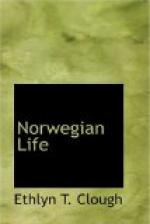Many of the wisest men in Norway consider the universal suffrage amendment to the constitution, which was passed in 1898, a mistake for this reason—because it removes a powerful incentive for men to accumulate money. The Norwegian has a large and natural fund of patriotism. He loves his country like the Swiss. Nowhere else do men and women have to work so hard for a living, but life is the more precious the harder one has to labor to sustain it. We value things according to their cost. In the tropics, where no man need work, human life is held cheaply. Men die and kill without compunction; they excite revolutions and overthrow governments, sparing neither themselves nor others. But in Norway, as in Switzerland, where it is a ceaseless struggle from the cradle to the grave, there is more national pride and patriotism than in any land, and the privilege of living and working and suffering is esteemed as the most precious inheritance of man.
Women in America who are working for the ballot have only to go to Norway to find that having a voice in the making of the laws of the country does not remove every obstacle to the progress of the sex; that there are still many injustices, and that the women work as hard as the men. The Norwegian woman usually carries a little more than her share of the load, and can support a husband without difficulty if he insists upon it. There is nothing so admirable in this world as a useful woman, particularly if she is married to a man inclined to leisure and loafing. In Norway and other countries of northern Europe the ballad, “I Love to See My Dear Old Mother Work,” is something more than an affectionate sentiment. It has a practical significance, and is frequently found in husbands as well as sons.
Of all the labor that the women of Norway engage in, especially women in the rural districts, is the occupation of caring for the saeter. A saeter is a summer ranch or dairy farm peculiar, to Norway—a cabin among the pastures way up in the mountains, where the cattle are driven during the summer months and butter and cheese are made. Almost every large farmer has a saeter. When the spring field work at home has been finished, the cattle are taken thither by the young women and girls,—often twenty and sometimes forty miles away,—where they stay during the summer and make butter and cheese, gather hay, knit stockings, and embroider linen. The dwelling is usually a rude hut with a single room, mud floor, an open fireplace without chimney, and a few pieces of rough furniture. Sheds and pens surround the hut, and there are patches of enclosed ground where hay is made and where the younger members of the flock are protected. The cattle are called at night by a horn made of birch bark. When blown lustily, it gives a clear note not unlike the cornet, and the cattle invariably respond to its sound.




